The Iguazu River -which means large water in Guaraní- flows into the Parana River creating a water blanket 1,500 meters wide, dotting islands and islets until it reaches a lava ravine formed 120 million years ago.
The Iguazu Falls National Park preserves the greatest biodiversity of the ecoregion of the Parana jungle.
During the course of the year, the temperature generally ranges from 12 ° C to 32 ° C in summer and 14 ° C in winter. Therefore, the best time to visit the Park is simply… all year round.
Iguazu Falls
National ParkUnique Natural Universe, Full of Life.
Natural World Heritage since 1984 and one of the 7 Natural World Wonder since 2011, the Iguazu Falls National Park is a unique natural universe. Full of life, abundant vegetation and more than 250 waterfalls, among them the Devil's Throat, falling more than 82 meters high; it is the ideal place to connect with nature.
Through walkways, adapted to wheelchairs and baby strollers, you can enjoy the jumps and the jungle, up close. Because experiencing nature in the Park is easily reached by all visitors.
The Ecological Train crosses the jungle until it reaches the entrance of the main walks, generating minimal environmental impact.
A new history in the Cataratas area of the Iguazu Falls National Park began in 2001, when the works of the entire new infrastructure were completed, seeking to protect the environment and the fragile area around the falls.
To implement the project of the Administration of National Parks supervised by the International Union of Conservation of Nature in a previously degraded area meant to reforest only with native species.
In addition, to preserve nature and its resources, an innovative wastewater treatment system was devised through a system of vegetated cells that transform waste in an ecological way.
In the Park there are
In 1984 the Iguazu Falls National Park
was declared a
Heritage
Since 2011,
the
Natural World,
New7Wonders foundation internationally.
of Brazil and Argentina
Argentine side.
Key
FiguresThe Falls are the result of a volcanic eruption,
The Park covers an area of
The waterfalls are
(1,7 miles) wide
The height of the jumps varies between
(200 y 269 feet)
The average water flow is
The Devil's Throat represents large part of water volume from the falls, an abyss
It´s the most impressive Jump in the Park and one of the most shared views in the world.
Photo
gallery
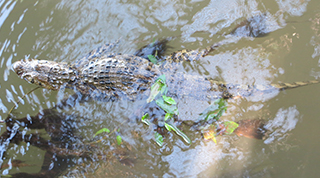
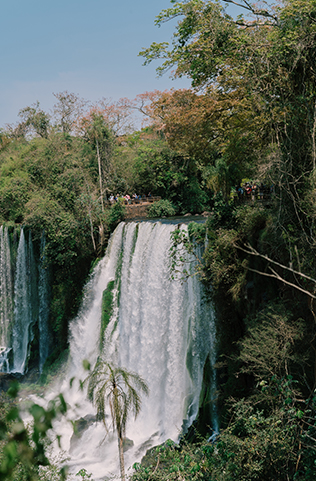
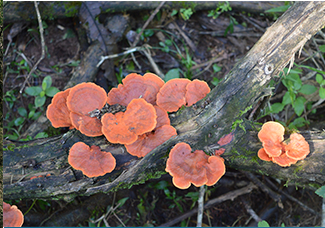
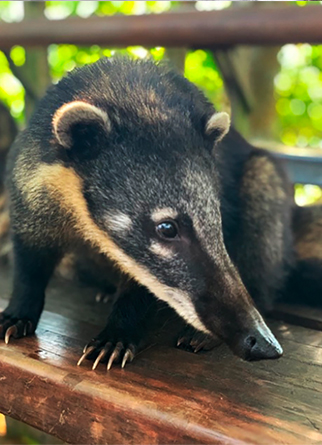
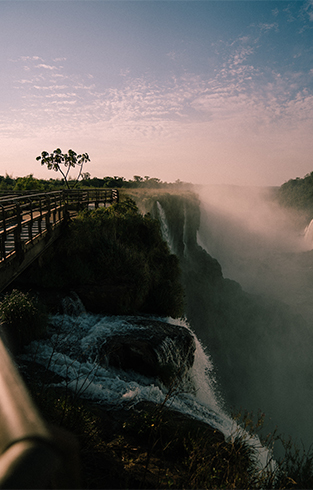
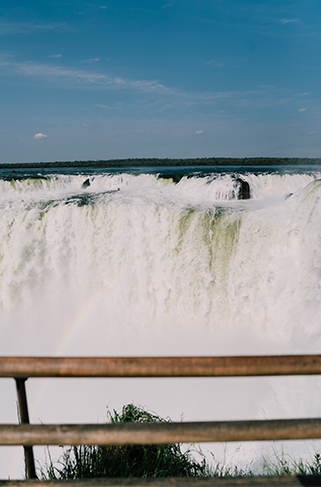
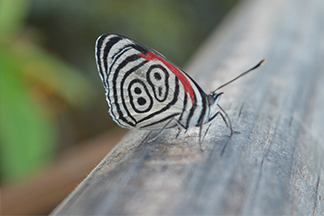
A Brief
History
1542 | Discovery of the Iguazu Falls
The explorer Alvar Núñez Cabeza de Vaca discovers the Falls and calls them “Saltos de Santa María.”
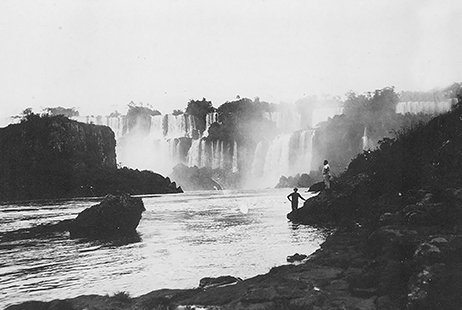
1882/3 | Iguazu Falls for sale
The expeditions of Ramón Lista, Giaccomo Bové and Gregorio Lezama arrived at the Falls, the latter guided by Carlos Bossetti. Lezama was the first owner of these lands. Considering them of little value, he sold them at a public auction whose ad read "a block of jungle that borders several waterfalls.". Its next owner, Domingo Ayarragaray, partially promoted it, placing a hotel and roads so that visitors could see the falls and exploited the local timber treasure until it was acquired by the government of President Hipólito Yrigoyen.

1934 | Declared a National Park
On October 9, after this incorporation into the national heritage, it was declared a National Park for its conservation and preservation, Protected by Law 12.103.
1995 | Call for a national and international tender for a public-private management of the Iguazu Falls National Park
The objective is to join forces to focus on the strengths of each party: National Parks, a public entity, protects natural resources and the environment. Iguazu Argentina, a private actor, works to provide a unique experience to the visitor, actively participating in the protection of the environment open to the public.

2011 | Natural World Wonder
The Iguazu Falls National Park was selected as one of the New 7 Natural World Wonder, in a universal ballot organized by the Swiss Foundation New Seven Wonders.
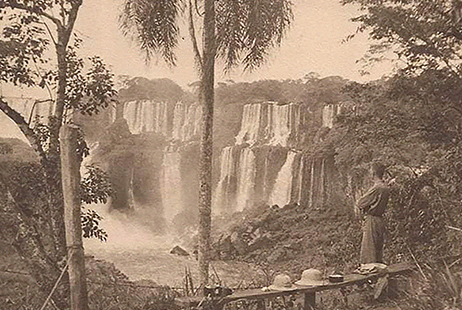
1608-1767 | Discovery of the falls
The area was occupied by the Jesuits, who arrived to evangelize the Guarani, inhabitants of these lands who lived in communion with the jungle. The Jesuits formed up to 30 Jesuit groups in the province of Misiones, north of Corrientes, south of Brazil and east to Paraguay. They cultivated yerba mate and tobacco, and the arts such as painting and carving of wood and stone, were developed.
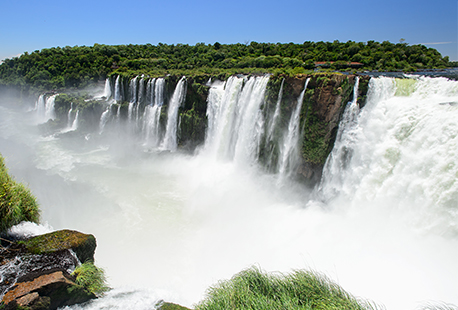
1902 | Iguazu Park and Reserve
Carlos Thays takes a detailed look at the Falls commissioned by the Argentine Ministry of the Interior and recommends the creation of the "Iguazu Park and Reserve."

1984 | UNESCO Natural World Heritage
The Iguazu Fall National Park is declared Natural World Heritage by the United Nations Educational, Scientific and Cultural Organization (UNESCO).

2001 | An Inclusive park
The completion of the works gives way to the Iguazu Falls National Park with accessible and inclusive walkways, trails, and the Ecological Train for the enjoyment of all, preserving the environment.

2013 | UNESCO Outstanding Universal Value
UNESCO qualifies the Iguazu Falls National Park as Outstanding Universal Value, since it is "a territory of such extraordinary cultural and natural importance that it transcends national borders and becomes important for present and future generations of all humanity."

1542 | Descubrimiento de los Saltos de Santa María
El explorador Alvar Núñez Cabeza de Vaca descubre las Cataratas y las llama “Saltos de Santa María”.

1608-1767 | Descubrimiento de las Cataratas
La zona fue ocupada por los Jesuitas, que llegaron para evangelizar a los guaraníes, habitantes de estas tierras que vivían en comunión con la selva. Los jesuitas formaron hasta 30 agrupaciones jesuíticas en la provincia de Misiones, norte de Corrientes, sur de Brasil y Paraguay. Cultivaban yerba mate y tabaco, y se desarrollaban artes como la pintura y la talla de la madera y la piedra.

1882/3 | Cataratas del Iguazú en venta
Llegan a las Cataratas las expediciones de Ramón Lista, Giaccomo Bové y Gregorio Lezama, estas últimas guiadas por Carlos Bossetti. Lezama fue el primer propietario de estas tierras . Por considerarlas de escaso valor, las vendió en un remate público, cuyo anuncio decía “bloque de selva que linda con varios saltos de agua.

1902 | Parque y Reserva del Iguazú
Carlos Thays releva detalladamente las Cataratas por encargo del Ministerio del Interior de Argentina y recomienda la creación del “Parque y Reserva del Iguazú”.

1934 | Declarado Parque Nacional
El 9 de octubre, luego de esta incorporación al patrimonio nacional, fue declarado Parque Nacional para su conservación y preservación, Protegido por la Ley 12.103.

1984 | UNESCO Natural World Heritage
The Iguazu Fall National Park is declared Natural World Heritage by the United Nations Educational, Scientific and Cultural Organization (UNESCO).
1995 | Llamado a licitación nacional e internacional para una gestión público-privada del Parque Nacional Iguazú.
El objetivo es unir fuerzas para concentrarse en las fortalezas de cada uno: Parques Nacionales, ente público, protege las riquezas naturales y el medio ambiente. Iguazú Argentina, concesionaria privada, trabaja para brindar una experiencia única al visitante, participando activamente a la protección del entorno abierto al público.

2001 | PaRQUE INCLUSIVO
La finalización de las obras dan paso al Parque Nacional Iguazú con las pasarelas, paseos, y el tren accesibles e inclusivos, para el disfrute de todos, preservando el medio ambiente.

2011 | Natural World Wonder
The Iguazu Falls National Park was selected as one of the New 7 Natural World Wonder, in a universal ballot organized by the Swiss Foundation New Seven Wonders.

2013 | Valor Universal Excepcional
La UNESCO califica al Parque Nacional Iguazú como Valor Universal Excepcional, dado que se trata de “un territorio de importancia cultural y natural tan extraordinaria que trasciende las fronteras nacionales y cobra importancia para las generaciones presentes y venideras de toda la humanidad”.

